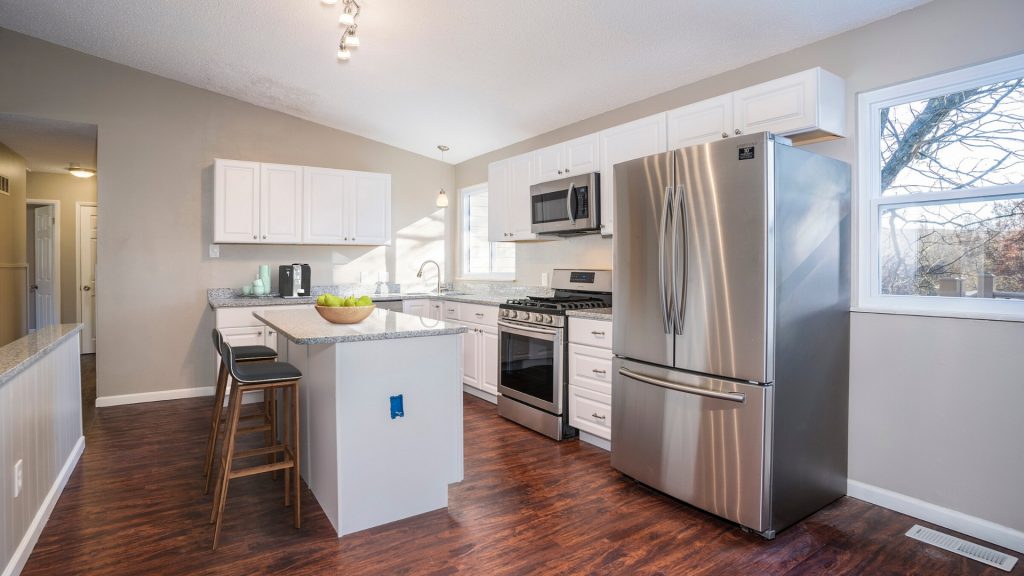Remodeling the Kitchen in An Old Maryland or Washington, DC, House
Remodeling the kitchen in an old home can be a challenge for many reasons. Depending on what type of person you are, you might want the kitchen to match the rest of the house. Or, you might prefer a more modern approach, even if the design is in sharp contrast to the adjacent rooms.
The problem with erring on the trendier side is that, in a few years, it may look dated, and you’ll be thinking about remodeling, yet again. If you choose a kitchen that doesn’t have the same character as the rest of your home, it might be a little weird; especially if there are architectural features that give a period feeling to the place.
Of course, you don’t want your kitchen to be just like it was when the house was built over a century ago. With all the modern features and appliances we have to choose from, there’s no need to skimp out on convenience just for the sake of authenticity. But, that doesn’t mean you can’t capture the essence of the period while still having all the bells and whistles of a dream kitchen.
Timeless Kitchen Design: The Best of Both Worlds
There are significant differences in kitchen design “then” and now. One of the main features of every kitchen is the cabinets, and that’s as good a place as any to start.
 Rethinking Your Cabinetry
Rethinking Your Cabinetry
Modern kitchen cabinets tend to have long, uninterrupted lines, where a century ago, several pieces of free-standing furniture did the job. Most of these did not match, either. You’d have a sideboard, a hutch, an armoire; all likely to be different styles, colors, and materials.
In an old-kitchen remodel, you can capture this look nicely with cabinetry that resembles free-standing furniture like that. Just because it’s built-in doesn’t mean it has to look like it is. Mix and match countertops to create prep zones or task areas. Create some texture with paint color, natural wood, and natural stone.
Another thing about cabinetry in older kitchens is that there are no inside corners. Modern cabinets generally have at least one 90-degree angle where the banks meet. When you don’t have this feature, it gives the room a more open and traditional look and feel.
Mixing And Matching
In a traditionally-styled kitchen, mixing and matching is encouraged. The cabinets are not the same style or shape; the paint isn’t the same color. Even the cabinet faces themselves can have different styles without the room looking too busy. It’s got to be done right, though; if there isn’t any sense of cohesion, it will look sloppy.
Choosing Appliances For An Old Kitchen Remodel
 While you probably don’t want to go with a 19th-century icebox, you can choose appliances that fit seamlessly into your décor. If you’re going for a traditional look, you don’t want to have an ultra-modern fridge or stove as they would stick out like a sore thumb.
While you probably don’t want to go with a 19th-century icebox, you can choose appliances that fit seamlessly into your décor. If you’re going for a traditional look, you don’t want to have an ultra-modern fridge or stove as they would stick out like a sore thumb.
There are a couple of ways you could go on this:
The more expensive choice would be to purchase high-end appliances that are made to accept cabinet panels. This will blend in nicely with the rest of the kitchen design as the units will look built-in.
For a budget-friendly alternative, you could purchase a standard fridge in the size you like and have cabinet panels mounted to it—ditto for the dishwasher.
Masquerading your stove is a little more complicated. Ranges and ovens, however, can be installed in an oversized cabinet. Retractable doors stow away when not in use, and you can lock everything down once the oven has cooled sufficiently.
A gas cooktop blends in well with the period look, and you can “hide” the hood fan in the cabinet above it.
The microwave, toaster, and other appliances can be concealed in the pantry or its own cabinet.
Reclaimed Materials, Modern Authenticity
Salvaged materials are perfect for a country kitchen vibe. Old barn wood, countertops from old country stores, and pressed glass panes in cabinet doors punctuate the décor without being too over-the-top.
A farmhouse apron-front sink always looks authentic, and while you likely wouldn’t want to pump the well for your water, there are fixtures that look remarkably like such things.
For an early-19th century look, you might consider a faux-grain paint on some of your cabinets, as this decorative technique was popular at that time.
Does your old kitchen need an upgrade? We’ve got plenty of ideas to bring it to life. Reach out today, and let’s talk about it.






Great post!